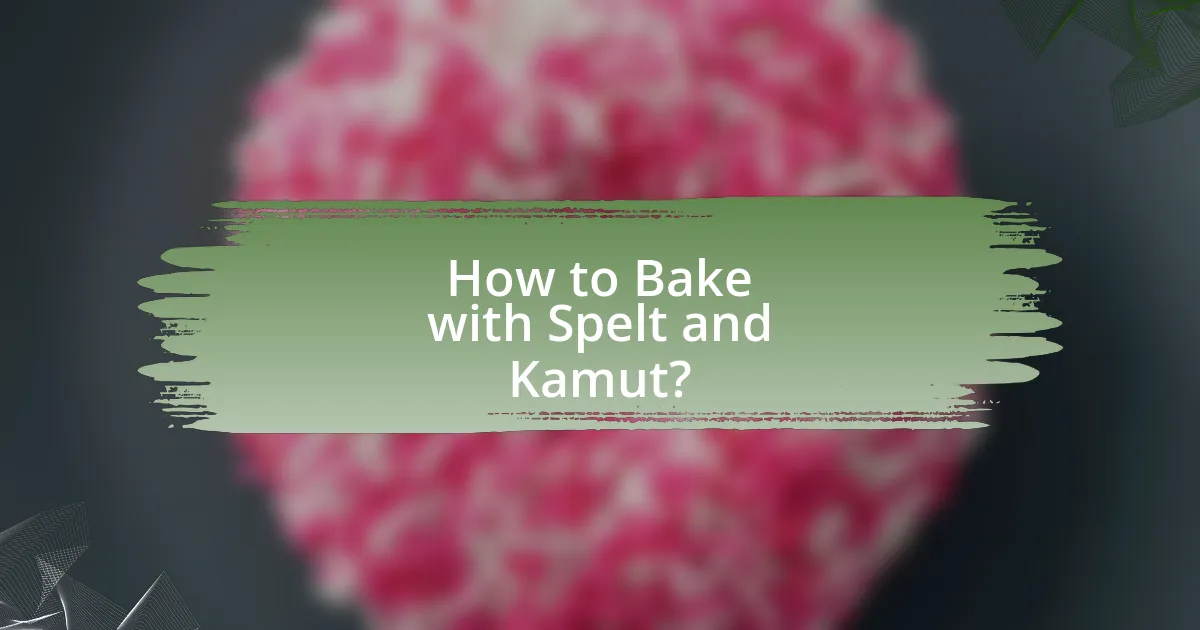Ancient grains, specifically spelt and Kamut, are cereal grains that have retained their genetic makeup over centuries, offering significant nutritional advantages over modern wheat. This article explores the historical significance, nutritional benefits, and baking applications of these ancient grains. It details how spelt and Kamut can enhance the nutritional profile of baked goods, their unique flavors, and the adjustments needed when incorporating them into recipes. Additionally, it addresses common challenges and best practices for successful baking with these grains, providing practical recipes to encourage their use in everyday cooking.

What are Ancient Grains and Why are They Important?
Ancient grains are cereal grains that have remained largely unchanged over the last several hundred years, including varieties such as spelt, kamut, quinoa, and farro. These grains are important because they offer nutritional benefits, including higher protein, fiber, and micronutrient content compared to modern grains like wheat. For example, spelt contains more protein and fiber than common wheat, making it a healthier choice for many diets. Additionally, ancient grains often have a lower glycemic index, which can help in managing blood sugar levels. Their cultivation also promotes biodiversity and sustainable agricultural practices, as they are typically more resilient to environmental changes.
How do Spelt and Kamut fit into the category of ancient grains?
Spelt and Kamut are classified as ancient grains because they have been cultivated for thousands of years, predating modern wheat varieties. Spelt, a type of wheat, has origins dating back to at least 5000 BC, while Kamut, an ancient Egyptian grain, has been grown for over 4,000 years. Both grains retain their original genetic makeup, making them less modified than contemporary grains. Their historical significance and minimal genetic alteration contribute to their classification as ancient grains, which are often valued for their nutritional benefits and unique flavors compared to modern wheat.
What historical significance do Spelt and Kamut hold?
Spelt and Kamut are historically significant as ancient grains that have been cultivated for thousands of years, with spelt dating back to around 5000 BC in the Near East and Kamut, a trademarked name for Khorasan wheat, believed to have originated in ancient Egypt. Their cultivation reflects early agricultural practices and dietary staples in various civilizations, contributing to the development of bread-making techniques. Archaeological evidence indicates that spelt was a staple in the diets of the Romans and was widely used in Europe during the Middle Ages, while Kamut was rediscovered in the 20th century, highlighting its nutritional benefits and historical roots.
How have Spelt and Kamut been used in traditional baking?
Spelt and Kamut have been used in traditional baking as ancient grains that offer unique flavors and nutritional benefits. Historically, spelt has been utilized in Europe for centuries, particularly in Germany and Switzerland, where it was commonly used to make bread and pasta due to its nutty taste and high protein content. Kamut, an ancient variety of durum wheat, has roots in the Middle East and has been traditionally used in bread-making and other baked goods, prized for its rich, buttery flavor and higher mineral content compared to modern wheat. Both grains have been incorporated into traditional recipes, reflecting regional baking practices and preferences, and are recognized for their digestibility and health benefits, making them popular choices in artisanal and health-focused baking today.
What nutritional benefits do Spelt and Kamut offer?
Spelt and Kamut offer significant nutritional benefits, including higher protein content, essential amino acids, and a rich supply of vitamins and minerals. Spelt contains approximately 15 grams of protein per 100 grams, which is higher than common wheat, while Kamut boasts around 18 grams of protein per 100 grams. Both grains are also excellent sources of dietary fiber, promoting digestive health, with Spelt providing about 10 grams and Kamut about 9 grams per 100 grams. Additionally, they are rich in B vitamins, particularly niacin and thiamine, which are crucial for energy metabolism. Kamut is particularly noted for its high selenium content, an antioxidant that supports immune function. These nutritional profiles make Spelt and Kamut valuable alternatives to conventional grains, contributing to a balanced diet.
How do the protein and fiber content of Spelt and Kamut compare to modern wheat?
Spelt and Kamut contain higher protein and fiber content compared to modern wheat. Specifically, spelt has approximately 14-15% protein and 10-12 grams of fiber per 100 grams, while Kamut offers around 15-16% protein and 9-11 grams of fiber per 100 grams. In contrast, modern wheat typically has about 10-13% protein and 2-3 grams of fiber per 100 grams. This difference in nutritional composition highlights the advantages of spelt and Kamut as more nutrient-dense options in comparison to modern wheat.
What vitamins and minerals are abundant in Spelt and Kamut?
Spelt and Kamut are abundant in several vitamins and minerals, particularly B vitamins, magnesium, iron, and zinc. Spelt contains high levels of niacin (B3), thiamine (B1), and riboflavin (B2), while Kamut is rich in selenium and has a higher protein content compared to modern wheat. Both grains provide essential nutrients that contribute to overall health, with spelt offering approximately 25% more protein than common wheat and Kamut providing about 65% more magnesium. These nutritional profiles make spelt and Kamut valuable choices for those seeking nutrient-dense grains.

How to Bake with Spelt and Kamut?
To bake with spelt and Kamut, substitute them for regular flour in recipes, typically using a 1:1 ratio for spelt and slightly less for Kamut due to its higher protein content. Spelt flour has a nutty flavor and can absorb more liquid, while Kamut flour offers a rich, buttery taste. Both grains have gluten, but spelt’s gluten is more fragile, so avoid over-kneading to prevent toughness. Additionally, spelt and Kamut can enhance the nutritional profile of baked goods, providing more fiber and protein compared to conventional wheat.
What are the key differences in baking with Spelt versus Kamut?
Spelt and Kamut differ significantly in baking due to their gluten content and flavor profiles. Spelt contains a more soluble form of gluten, which can lead to a lighter texture in baked goods, while Kamut has a higher protein content and a nuttier flavor, resulting in denser products. Additionally, Spelt absorbs more water, requiring adjustments in liquid ratios, whereas Kamut’s robust flavor can enhance the taste of bread and pastries. These differences are rooted in their genetic makeup; Spelt is an ancient wheat variety with a softer gluten structure, while Kamut, a trademarked ancient grain, is known for its rich nutritional profile and distinct taste.
How does the gluten content of Spelt and Kamut affect baking?
The gluten content of Spelt and Kamut significantly influences baking outcomes. Spelt contains a unique form of gluten that is more water-soluble than that found in modern wheat, resulting in a lighter texture and improved dough extensibility. Kamut, on the other hand, has a higher protein content, which contributes to stronger gluten formation, leading to denser and chewier baked goods. Research indicates that the gluten in both grains can enhance the flavor profile and nutritional value of baked products, making them appealing alternatives to conventional wheat.
What adjustments should be made to recipes when using Spelt or Kamut?
When using Spelt or Kamut in recipes, adjustments include reducing the liquid by about 10-20% and decreasing the overall flour amount by 10-15% compared to regular wheat flour. Spelt and Kamut have different absorption properties and gluten structures, which necessitate these modifications to achieve the desired texture and consistency in baked goods. Research indicates that Spelt flour has a higher water solubility, leading to a need for less liquid, while Kamut’s larger grain size requires less flour to maintain balance in recipes.
What types of baked goods can be made with Spelt and Kamut?
Spelt and Kamut can be used to make a variety of baked goods, including bread, muffins, pancakes, cookies, and pasta. These ancient grains have unique flavors and nutritional profiles that enhance the quality of baked products. For instance, spelt flour is often used in artisan bread recipes due to its nutty taste and ability to retain moisture, while Kamut flour is known for its rich, buttery flavor, making it ideal for cookies and pastries. Both grains are high in protein and fiber, contributing to the health benefits of the baked goods made from them.
How can Spelt and Kamut be used in bread making?
Spelt and Kamut can be used in bread making by substituting them for traditional wheat flour, as both grains have unique properties that enhance flavor and nutrition. Spelt flour contains a higher protein content and a different gluten structure, which can result in a denser bread with a nutty flavor. Kamut, known for its rich, buttery taste, also offers a higher protein and mineral content compared to regular wheat, contributing to a more nutritious loaf. When using these grains, bakers often adjust hydration levels due to their different absorption rates, ensuring optimal dough consistency.
What are some popular pastries and desserts that incorporate Spelt and Kamut?
Popular pastries and desserts that incorporate Spelt and Kamut include spelt cookies, Kamut brownies, spelt pancakes, and Kamut bread. Spelt cookies are known for their nutty flavor and chewy texture, while Kamut brownies offer a rich, dense chocolate experience. Spelt pancakes are often praised for their lightness and nutritional benefits, and Kamut bread is recognized for its hearty, slightly sweet taste. These baked goods leverage the unique properties of these ancient grains, which are higher in protein and fiber compared to conventional wheat, making them a nutritious choice for various recipes.

What are the Best Practices for Using Spelt and Kamut in Baking?
The best practices for using spelt and Kamut in baking include adjusting hydration levels, using a lower protein content flour, and allowing for longer fermentation times. Spelt flour typically absorbs more water than regular wheat flour, so increasing the liquid in the recipe by about 10-15% is advisable. Kamut, known for its rich, nutty flavor, has a lower gluten content, which means recipes may require additional binding agents or longer mixing times to achieve the desired texture. Additionally, both grains benefit from longer fermentation, which enhances flavor and digestibility, as evidenced by studies showing that extended fermentation improves the nutritional profile of baked goods.
How can one ensure the best texture and flavor when baking with these grains?
To ensure the best texture and flavor when baking with spelt and Kamut, one should use a combination of proper hydration and temperature control. Spelt and Kamut have different absorption rates compared to conventional wheat, requiring adjustments in liquid ratios; typically, increasing the water content by 10-15% enhances the dough’s elasticity and moisture. Additionally, baking at a slightly lower temperature helps preserve the delicate flavors and prevents over-browning, which can mask the grains’ natural nuttiness. Research indicates that spelt flour contains higher levels of protein and fiber, contributing to a chewier texture, while Kamut’s rich, buttery flavor can be highlighted by allowing the dough to rest longer, promoting better gluten development.
What tips can help in achieving the right dough consistency with Spelt and Kamut?
To achieve the right dough consistency with Spelt and Kamut, it is essential to adjust hydration levels due to their unique absorption properties. Both grains require more water than traditional wheat; typically, a hydration level of 70-80% is recommended for Spelt and slightly higher for Kamut. Additionally, incorporating a longer fermentation time can enhance gluten development, which is crucial for achieving the desired texture. Research indicates that Spelt flour has a different gluten structure, making it more sensitive to over-kneading, so gentle mixing is advised. These adjustments ensure that the dough maintains elasticity and structure while preventing it from becoming too dry or overly sticky.
How can one store Spelt and Kamut flour for optimal freshness?
To store Spelt and Kamut flour for optimal freshness, keep the flour in an airtight container in a cool, dark place, such as a pantry or cupboard. This method prevents exposure to light, moisture, and air, which can lead to rancidity and loss of flavor. Additionally, for extended storage, consider refrigerating or freezing the flour, as studies show that low temperatures can significantly prolong shelf life by slowing down the oxidation process. Properly stored, Spelt and Kamut flour can maintain quality for several months, ensuring that the nutritional benefits and flavor remain intact.
What common challenges might arise when baking with Spelt and Kamut?
Baking with Spelt and Kamut presents common challenges such as differences in gluten structure and hydration requirements. Spelt contains a more fragile gluten network compared to modern wheat, which can lead to denser baked goods if not handled properly. Kamut, while having a higher protein content, absorbs more water, necessitating adjustments in liquid ratios to achieve the desired dough consistency. These factors can result in difficulties in achieving the right texture and rise in baked products, as evidenced by bakers often needing to experiment with ratios and techniques to optimize results.
How can one troubleshoot issues related to dough rising and texture?
To troubleshoot issues related to dough rising and texture, one should first ensure the yeast is active, as inactive yeast can prevent proper rising. Checking the expiration date of the yeast and proofing it in warm water with sugar can confirm its viability. Additionally, the dough’s hydration level is crucial; if the dough is too dry, it will not rise properly, while overly wet dough can lead to poor texture. Adjusting the flour-to-water ratio can help achieve the right consistency. Temperature also plays a significant role; dough should be allowed to rise in a warm, draft-free environment, ideally between 75°F and 80°F, to promote yeast activity. Lastly, kneading the dough adequately develops gluten, which is essential for structure and texture; insufficient kneading can result in dense bread.
What are some common mistakes to avoid when using Spelt and Kamut in recipes?
Common mistakes to avoid when using Spelt and Kamut in recipes include not adjusting liquid ratios, neglecting to account for their unique gluten properties, and failing to consider their distinct flavors. Spelt and Kamut absorb more liquid than regular wheat, so recipes often require additional water or other liquids to achieve the desired consistency. Additionally, both grains have a different gluten structure, which can affect the rise and texture of baked goods; thus, over-kneading can lead to dense results. Lastly, their nutty and slightly sweet flavors can overpower other ingredients if not balanced properly, so it’s essential to adjust seasonings accordingly.
What are some practical recipes to try with Spelt and Kamut?
Practical recipes to try with Spelt and Kamut include spelt bread, kamut pasta, and spelt pancakes. Spelt bread utilizes whole spelt flour, water, yeast, and salt, resulting in a nutty flavor and dense texture. Kamut pasta can be made by mixing kamut flour with eggs and water, creating a rich, hearty pasta that pairs well with various sauces. Spelt pancakes require spelt flour, milk, eggs, and baking powder, yielding fluffy pancakes that are nutritious and flavorful. These recipes highlight the versatility of both grains in everyday cooking.




